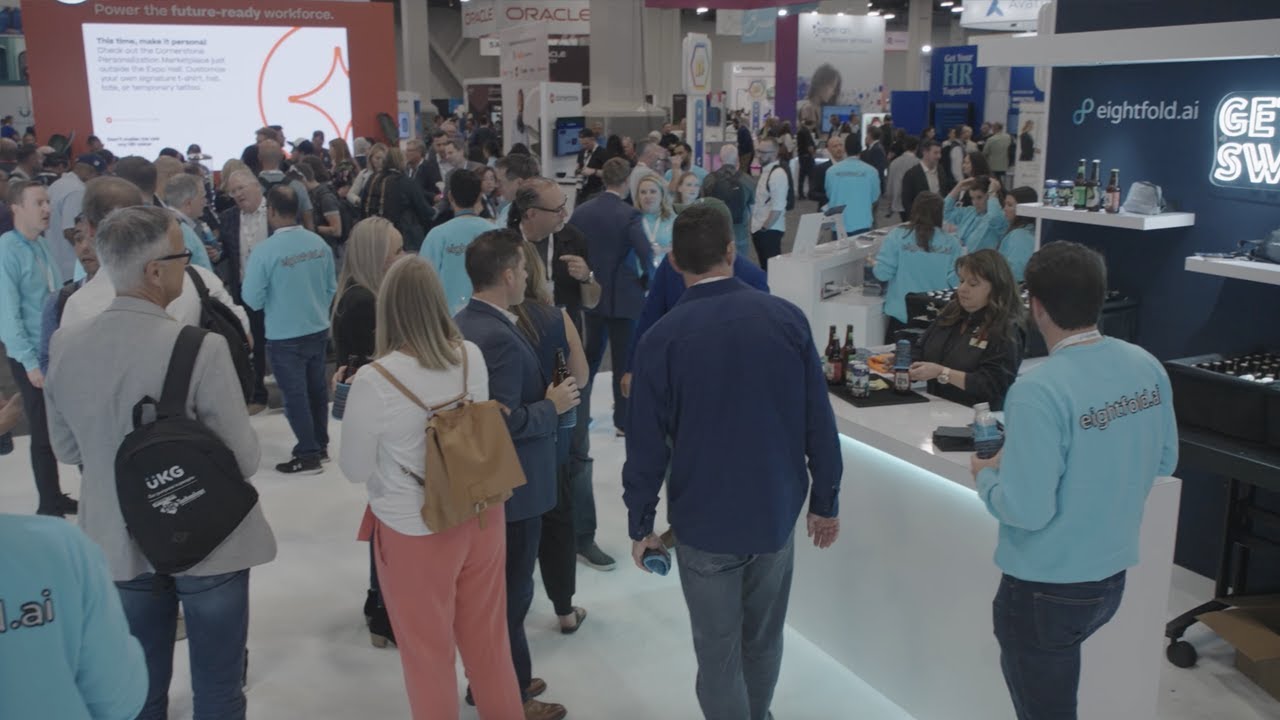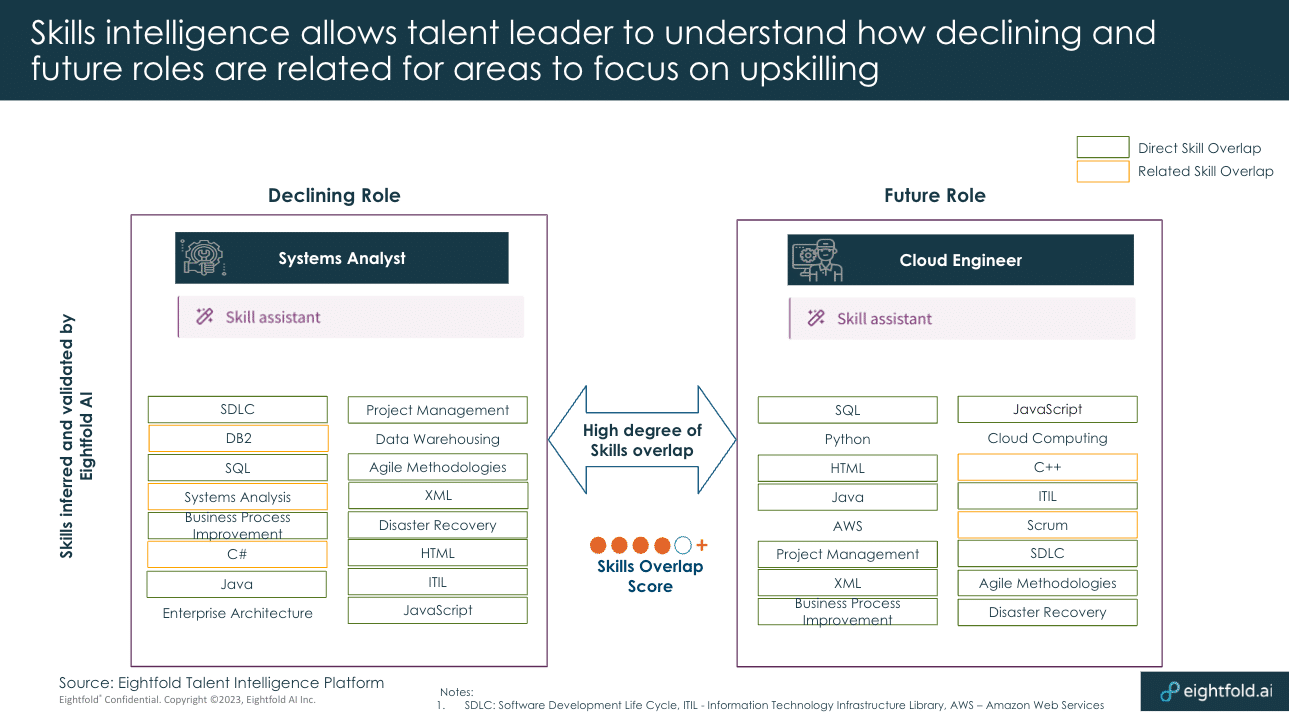“November 30 last year was when OpenAI released ChatGPT, and it really is almost like BC and AD in the world of technology and work because so much is going to change,” — David Mitchell, Partner, Transformation and Future of Work at Mercer
As the nature of work evolves, the importance of skills in the modern workforce is becoming undeniable. Organizations are no longer just hiring for positions but rather seeking specific skill sets. Amplifying this transformation is the rise of AI — which, most experts agree, won’t replace humans, but amplify their unique strengths.
In a recent webinar, Eightfold’s VP of Talent Transformation, Andrea Shiah, and Mercer Partner David Mitchell explored how AI and skills-based work will lead to a more productive, future-ready workforce. Below are several takeaways from their conversation.

Related content: From our latest product launch to news from Josh Bersin and analysts, HR Tech was filled with highlights.
Generative AI and the productivity advantage
According to research from OpenAI, more than eight in 10 jobs are likely to be affected by generative AI. That’s not necessarily a bad thing. Data shows that workforce productivity has been steadily decreasing for decades, despite a small uptick in Q2 of this year. And, as inflation spirals, labor has become increasingly expensive. A focus on skills presents a better way to harness what employees have to offer.
“AI says both, ‘How do we have the right skills for the future?’ and ‘How do we go into the nuts and bolts, the sausage-making, of each of our jobs, and start incorporating [AI]?’” Mitchell said. “Not as replacing the human worker, but augmenting us with this additional knowledge and productivity tools to get more productive.”
This productivity boost is exactly what modern organizations need, especially as they aim to do more with less. This workforce automation and transformation isn’t something to fear. It’s been happening continuously since factory lines in the 1950s.
“Technology, again, isn’t replacing us,” Mitchell said. “It’s replacing the transactional parts of our jobs and augmenting the relational and expert aspects of work, enabling each of us to lean into those skills that make us most productive and that provide meaningfulness.”
The shift from transactional to relational work
As AI technologies — like talent intelligence, gen AI, and robotic process automation — take on more monotonous responsibilities, employees are being freed from the confines of repetitiveness.
“Large parts of our day and many jobs, when we break them down into hours, 30% to 40% of our time can be that transactional stuff,” Mitchell said. “Here’s where [AI] can come in and do the summarizing and the content creation.”
Work that can be easily automated includes setting up and maintaining spreadsheets; creating communications materials, like presentations or client emails — and yes, even sorting a large number of applications and surfacing the most relevant ones in talent acquisition.
When monotonous or manual tasks are automated, employees can use their newfound time to dive deeper into work, including more thoughtful analysis and strategic planning, or connecting with people. AI can’t replicate areas of human strength, like intuition, emotional intelligence, and creativity.
“As transactional skills are increasingly automated, relational skills will become more important,” Mitchell said. “Skills around being able to have empathy to understand a client’s needs, or if I’m in HR, leadership development — those kinds of skills are just going to rocket ship up in importance.”
The rise of the talent marketplace
AI will help workers become more productive, and it will also help businesses make better decisions, especially when it comes to aligning specific skills and tasks without being limited by organizational structures and cost centers.
“We’re going to be able to take our individuals, their skill sets, and those tasks, and do these very flexible mashups to advance key enterprise initiatives,” Mitchell said. “Some organizations call them tiger teams – cross-functional talent with key skills come together for a specific period to deliver critical projects, then the team disbands and people are reassigned to the next big thing.”
Real-time talent insights allow for organizations to understand their workers’ skills in real time and match them to opportunities, projects, gigs, and outcomes. The focus is no longer on fitting a mold, but on flexible working arrangements that allow multiple teams to tap into a person’s skills, maximizing their exposure to the organization and their productivity.
The shift away from traditional employment models
Our traditional understanding of employment — with its strict hierarchies, clear-cut roles, and well-defined job descriptions — is also being reimagined. Pioneering this change is the gig economy, the rise of project-centric roles, and an organizational shift toward in-house flexibility.
Modern organizations are embracing the potential of a diverse talent ecosystem that includes full-time employees and part-time contributors, freelancers, and gig professionals. The criteria? A person’s skill set and the unique value they bring. These agile workforce models give organizations ultimate flexibility in ensuring they have the skills needed to succeed.
The use of real-time skills data
As organizations use AI and talent intelligence to understand the current skills mix, their leaders can also keep an eye on rising or declining skills, and make proactive plans to upskill, reskill, or hire for those missing skills.
For example, let’s look at a role in IT. Eightfold data shows that while a systems analyst role may be declining, the skills used for that role overlap with the future-focused role of a cloud engineer. “We can see with the intelligence and data that these two roles have a high overlap of skills,” Eightfold’s Shiah said.
“Upskilling is a win-win, right?” she continued. “It’s a win for the organization because you’re building the skills that are critical to your business success, but it’s also a win for your employees because they’re building skills that are going to be relevant for the future.”

Skills intelligence can show you what roles are rising and declining — and related transferable skills.
If organizations need to hire, they can tap into talent intelligence to exponentially widen the talent pool. Eightfold, for example, is a talent intelligence platform that uses data from over half of the entire global workforce — billions of data points — to predict skills learnability based on common skill progressions and career pathways.

Adjacent skills are good indicators that someone can easily learn a new skill.
“If you look at Agile methodologies, Scrum, user-centered design — some of these skills are basically predictors that you can acquire Agile-methodologies skills readily,” Shiah said. “The power of this — if you look at the gold box on the right — is that you’re able to increase your pool of candidates, whether you’re looking internally or externally, pretty substantially. Right, anywhere from three times for Python, if you consider these adjacent skills, and up to 12 times for financial modeling.”
The ‘new work’ framework
As AI technologies become intertwined with workers’ professional lives, the onus is on organizations to foster a culture of continuous learning, evolution, and innovation. This new framework comprises four principles, each meant to support a more effective and efficient work operating system.
The four principles of the new work operating system are:
- Start with the work, including current and future tasks, and not existing jobs.
- Achieve the optimal combination of humans and automation.
- Consider the full array of human work engagements. For instance, jobs, gigs, freelance, alliances, projects, and any other arrangements.
- Allow talent to “flow” to work versus being limited to fixed, traditional roles.
These four principles help support the approach to reinventing work by deconstructing and reconstructing roles to reskill pathways and decrease the need to eliminate roles. By looking at the work and the time allocation of the job, organizations can better understand what skills will be needed and where automation has a place.
“When I consider a registered nurse, they have a specific skill set or certification that is essential for the job,” Mitchell said. “Yet roles like telehealth or patient navigator tap into a similar skill set. Imagine if hospitals offered a blend: three days a week as an RN in a clinic and two days from home in a telehealth role. Both positions hinge on the core nursing skill set. While the telehealth role might require enhanced communication abilities, combining roles can lead to significant decreases in turnover and burnout. This versatile approach can be applied not just in healthcare, but in sectors like warehousing and manufacturing, too.”
The age of AI in workforce strategy
AI is more than a technological advancement — it’s changing how we view and engage talent moving forward. HR leaders are not just witnesses to this change but are central to driving it. Their role is to adapt and pioneer new ways to excel in this AI-centric work environment. Armed with the right tools and insights, HR professionals are the key players in designing the future of work.
Watch the full webinar, “Skills at the core: Unleashing the power of modern work design,” to learn more about how a skills-based approach to work design can unlock human potential, boost employee engagement, and drive organizational performance.










